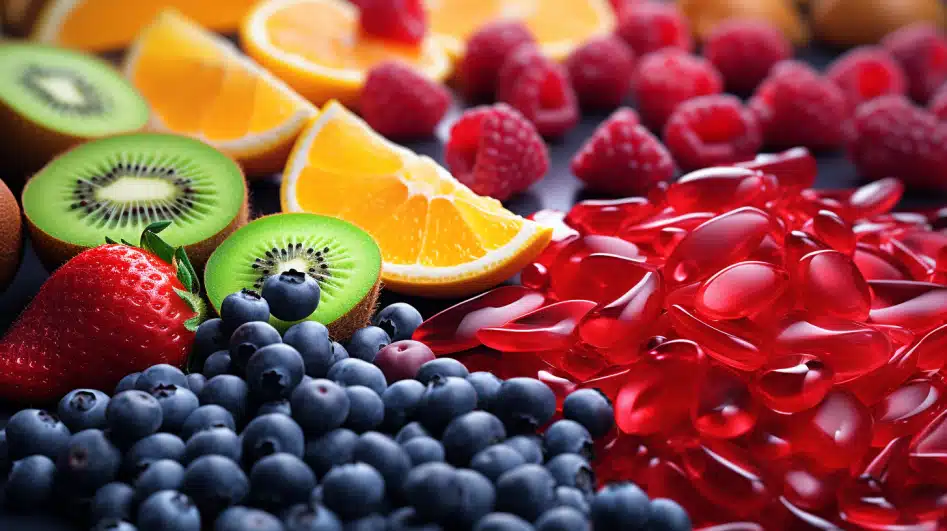Eating foods rich in certain flavonoids may help lower the risk of experiencing depressive symptoms, suggests new research based on U.S. national health data.
Key facts:
- Higher intakes of anthocyanidins, flavanones, flavones, and isoflavones were associated with lower odds of depressive symptoms after adjusting for confounders.
- There was an inverse association between total flavonoid intake and depressive symptoms risk among women but not men.
- A potential U-shaped relationship exists between total flavonoid intake and depressive symptoms risk, with benefits tapering off at very high intakes.
Source: J Affect Disord (2023)
Antidepressant Effects of Flavonoids
Flavonoids are a large family of polyphenol compounds found naturally in many fruits, vegetables, nuts, seeds, stems, flowers, teas, wines, and other plant-based foods and beverages.
Over 6000 unique flavonoids have been identified by scientists so far. They are responsible for the vivid colors of blueberries, raspberries, cherries, and other colorful produce.
Research over the past few decades suggests that generous intakes of dietary flavonoids could have far-reaching benefits for health.
Studies link them to lower risks of heart disease, cancer, diabetes, and other chronic conditions. Exciting new evidence indicates they may also play a role in supporting mental health.
A cross-sectional study just published in the Journal of Affective Disorders analyzed flavonoid intakes and depressive symptoms data from over 9600 US adults who took part in national surveys from 2007-2010 and 2017-2018.
After adjusting for potentially confounding factors, the researchers found significant associations between intakes of certain flavonoids and lower likelihood of moderate-to-severe depressive symptoms.
Specific Flavonoid Groups Linked to Lower Depressive Symptoms
The key flavonoid subclasses highlighted by the study were:
Anthocyanidins: Pigments that give red/blue berries and red grapes their vivid coloration. Associated with a 30% lower depressive symptoms risk at the highest versus lowest intakes.
Flavanones: Abundant in citrus fruits. Associated with 30-35% lower risk at higher intakes.
Flavones: Found in parsley, celery, hot peppers. Linked to 33-40% lower risk.
Isoflavones: Mainly from soy foods. Associated with a 35% lower risk at moderate (not high) intakes.
For total flavonoids, a U-shaped relationship was uncovered.
Intakes between 76 mg/day and 665 mg/day were associated with progressively lower depressive symptoms odds before risk plateaued.
Very high or very low intakes were linked to higher risks.
Possible Biological Mechanisms of Flavonoids on Mood
Multiple biological mechanisms likely underlie the apparent antidepressant effects of flavonoids suggested by the data:
- Anti-inflammatory effects in the brain
- Protecting neuron health
- Boosting serotonin, dopamine, BDNF
- Improving vascular function
- Supporting the gut-brain axis
The researchers explain that flavonoids’ abilities to interact with cell receptors, enzymes, signaling pathways, and gene expression contribute to these mental health benefits.
For example, they can increase neurogenesis, strengthen connections between neurons, and prevent cell death pathways associated with depression.
Sex/Gender Differences: Benefits Only in Women?

Intriguingly, further analysis indicated that total flavonoid intakes were linked to lower depressive symptoms specifically in women.
There was no significant relationship observed in men.
This could relate to the phytoestrogenic effects of flavonoids.
By binding to certain estrogen receptors, they appear able to mimic beneficial effects of estrogen in the female brain.
Estrogen supports mental health in women partly by boosting central nervous system levels of mood-regulating neurotransmitters like serotonin and norepinephrine.
Flavonoids’ abilities to activate estrogen receptor pathways may confer similar effects.
Putting Research Findings Into Context
This research synergizes with prior international studies suggesting potential mood benefits of foods rich in certain flavonoids. For example:
- A 2016 study of over 80,000 older American women associated higher intakes of citrus fruit flavanones with lower depressive symptoms risk over time.
- Trials in patients with depression found improvements in symptoms after supplementation with anthocyanin-rich blueberry and purple sweet potato juice.
- An analysis of diet and mental health data from nearly 4000 older Chinese adults linked higher soy isoflavone consumption to lower risk of depressive symptoms.
Limitations & Next Steps
As a cross-sectional study, cause-and-effect relationships cannot be confirmed.
And self-reported dietary data can be prone to inaccuracy.
To build on these initial findings, the researchers call for prospective cohort studies tracking flavonoid intakes and mental health over longer periods.
Clinical trials testing effects of specific flavonoids are also needed.
If future research continues finding a protective link between flavonoids and depressive symptoms, public health bodies may one day recommend increasing intakes of red/blue fruits and vegetables, citrus, soy, and other flavonoid-rich foods to help address depression burdens.
For now, these colorful compounds show promising potential for promoting brain and mental wellbeing in both men and women.
How to Boost Dietary Flavonoid Intake
Want to enjoy more flavonoids and their potential benefits?
Try incorporating these delicious foods:
- Anthocyanin-rich: berries, cherries, red grapes, plums, red cabbage
- Flavanone-rich: oranges, grapefruit, lemons
- Flavone-rich: parsley, thyme, celery
- Isoflavone-rich: tofu, edamame, tempeh
Balancing whole grains, healthy fats, proteins, and probiotic foods supports optimal absorption and metabolism of flavonoids.
But don’t overdo it — very high intakes don’t necessarily confer greater benefits according to the recent research.
References
- Study: Dietary flavonoid intake is associated with a lower risk of depressive symptoms in US adults: Data from NHANES 2007-2008, 2009-2010, and 2017-2018
- Authors: Jin Lin et al. (2023)







